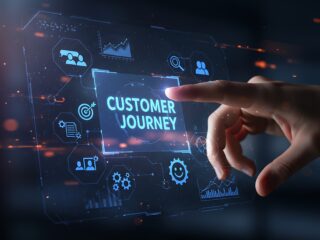What is Attribution?
One of the primary reasons companies invest in marketing analytics is the desire to understand the “customer journey” — and how various marketing touchpoints along that journey contribute to positive outcomes, like purchases or other conversions. Attribution, in the context of Google Analytics 4 (GA4), refers to the process of assigning credit to those various touchpoints along a user’s path to conversion. It’s the means by which marketers discern the impact of different channels and interactions, unraveling the complexity of user behavior.
In a nutshell, attribution answers the pivotal question: How did users arrive at the point of conversion? GA4, with its user-centric approach, goes beyond simple last-click attribution, providing a more sophisticated understanding of the entire conversion journey.
How Do GA4’s Attribution Models Affect My Data?
A quick word of warning before we jump into attribution: by default, if you go into the “Attribution settings” in the GA4 Admin panel, you will see that “Data-driven” is selected as the “Reporting Attribution model.” Contrary to conventional wisdom, this does not mean that this is the only attribution model being applied in your reporting.
Indeed, user- and session-scoped reports, including some of the most commonly used for channel reporting, like the “Traffic Acquisition” and “User Acquisition” reports, do not follow this model. The same goes for all session- and user-scoped dimensions, like First User Default Channel Grouping, Session Custom Channel Grouping, and Session Source. These dimensions follow the “Paid and Organic Last Click” model, regardless of what you select. More on what this means in the next section but, in short, this closely resembles how Universal Analytics (UA) attributed credit solely based on the last non-direct click. It is only for event-scoped dimensions in GA4, like “‘Default Channel Grouping,” that this selectable model applies. Also, changing this model will affect how conversion credit gets attributed moving forward only — it’s not retroactive to historical conversions.
Attribution Models in GA4
GA4 currently offers three attribution models to choose from, each shedding light on user interactions from a different perspective. Choosing the right model depends on the specific goals and nuances of your business. Let’s explore the attribution models available in GA4:
Paid and Organic Last Click
- Overview: Attributes 100% of the conversion credit to the last touchpoint before the conversion. Ignores direct traffic, unless it is the only touchpoint in the user’s path to conversion. This model is also commonly known as a ‘Last non-direct click’ model.
- Recommended for: Organizations with short and straightforward sales cycles where the last interaction is the most influential. This model provides a holistic view of both paid and unpaid channels.
Paid Channels Last Click
- Overview: Attributes 100% of the conversion credit to the last Google Ads touchpoint before the conversion. When no Google Ads touchpoint exists, it reverts to Paid and Organic Last Click. This model ignores direct traffic unless it is the only touchpoint in the user’s path to conversion.
- Recommended for: Organizations using Google Ads whose primary goal is measuring the impact of their paid marketing spend.
Data-Driven
- Overview: Distributes credit fractionally, based on a machine learning algorithm that evaluates converting and non-converting paths. As per Google, the model “incorporates factors such as time from conversion, device type, number of ad interactions, the order of ad exposure, and the type of creative assets.” Ignores direct traffic unless it is the only touchpoint in the user’s path to conversion.
- Recommended for: Organizations where multiple touchpoints often factor into the sales cycle, which would not be captured in a winner-take-all model.
- Note: Fractional credit may not be well-understood by stakeholders that have been accustomed to last-click models.
Attribution Models in Practice
Let’s take an example of a user’s path to conversion to demonstrate how credit for the conversion would be assigned differently under each model.
Direct > Display > Organic Search > Google Paid Search > Organic Search
- Paid and Organic Last Click: organic search gets 100% of the conversion credit because it is the last touchpoint in the path.
- Paid Last Click: Google paid search gets 100% of the credit because it is the last Paid touchpoint in the path.
- Data-Driven: Direct 0%, Display 10%, Organic Search 70%, Google Paid Search 20% (numbers are for illustrative purposes only)
- Direct is given 0% because Direct is excluded from receiving credit unless the path consists only of direct visit(s)
- Display receives fractional credit for its role in driving the user to conversion, unlike under the other 2 models
- Organic Search receives the majority of the credit because it appeared twice in the user’s path, and was the most recent touchpoint before conversion
Lookback Windows
One very important factor we haven’t mentioned yet is lookback windows. In GA4, lookback windows play a crucial role in determining how far back in time user interactions are considered when attributing conversions.
The lookback window, set by default at 90 days, can be adjusted to align with your particular sales cycle and reporting needs. This period defines the timeframe during which interactions are eligible for attribution credit. Lookback window settings apply to all reports, including user and session-scoped reports like the ‘Traffic acquisition’ and ‘User acquisition’ reports.
By shortening that timeframe, you will likely find that Direct traffic takes up a larger share since categorization of traffic into the ‘Direct’ channel is only done when no other non-Direct touchpoints in the user path are available within the lookback window, regardless of the attribution model. Changing the lookback window only affects data from the time of the change onwards.
For marketers, understanding and appropriately configuring the lookback window is essential for gaining accurate insights into the customer journey, optimizing attribution models, and making informed decisions based on recent and/or historical user interactions.
M|CP’s Perspective
Attribution in GA4 is the key to unlocking actionable insights that transcend traditional last-click models. The diverse attribution models cater to the multifaceted nature of user interactions, allowing businesses to tailor their approach based on specific goals and user behavior.
Platform-specific reporting within the walled gardens of Google, Facebook, etc. have been known to overvalue their own contributions, and undervalue other channels in the user’s journey. GA4 can help to mitigate this by providing an unbiased, holistic view across channels.
For that reason, M|CP recommends keeping the “Reporting Attribution model” set as “Data-driven,” especially since the “Paid and Organic Last Click” model is automatically applied on session and user-scoped dimensions. In many ways, this approach gives you the best of both worlds, where you can use and compare both models at once. In addition, as “data deprecation” continues to advance, the future of attribution is likely to involve an ever-greater reliance on modeling. While there’s likely some education needed to ensure stakeholders understand how modeled attribution works — compared to rules-based attribution models — investing in that kind of education now makes a lot of sense.
The main use case for choosing “Paid and Organic Last Click” would be to reduce any potential confusion of having different models in use at once. Stakeholders accustomed to UA may also prefer to match their GA4 attribution as closely as possible to how it was done previously in UA. So, it’s nice to have this model available as an option, but we don’t recommend heavy reliance on it by default.
Choosing the right attribution model requires a thoughtful analysis of business objectives, sales cycle complexity, and the influence of various channels. The impact of attribution models extends beyond individual conversions; it shapes how marketers interpret data, allocate marketing budgets, and refine strategies













